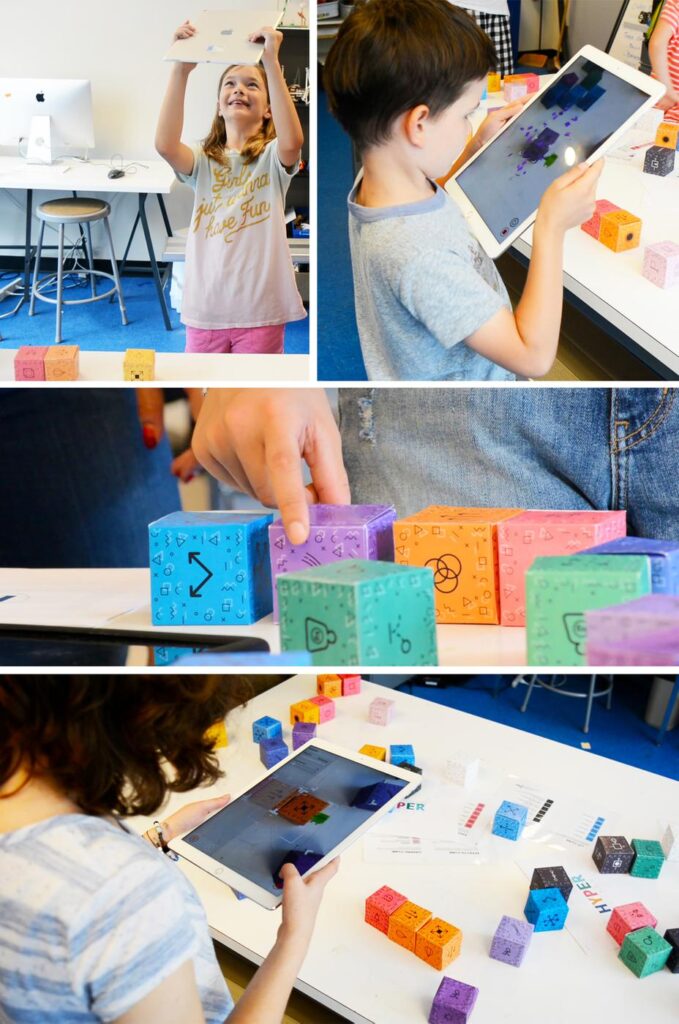According to a report published by Innovation and Science Australia (2017), in surveying the skills needed for jobs in the future, 92% of them required digital competence. The report further asserts that 45% of those jobs required not only the ability to design digital systems and technology but to also have the confidence in doing so.
The realization of the need to acquire digital skills in order to meet demands of the future workforce is growing among parents and educators alike. Hard skills aside, there is also a need to develop other soft skills such as problem-solving, collaboration, resilience, and creativity, amongst others.
In a bid to learn more about the transformation happening to classroom education globally, Google for Education partnered with researchers from around the world to produce a study titled Future of the Classroom. Out of this report, 8 emerging trends were found in K-12 education:
- Digital responsibility
- Computational thinking
- Collaborative classrooms
- Innovative pedagogy
- Life skills & workforce preparation
- Student-led learning
- Connecting guardians & schools
- Emerging technologies
In this post, I’d like to investigate further two of the trends from the above list – computational thinking and emerging technologies. I aim to briefly study the evolution of computational thinking in education and explore the use of emerging technologies to promote computational literacy.
What is Computational Thinking
While widely popularized by Jeannette Wing in 2006, the term “computational thinking” was first used in 1980 by Seymour Papert, a founding faculty member of the MIT Media Lab.
Computational thinking is a method for complex problem solving. At its core, computational thinking involves the ability to understand and pinpoint the problem, then conceive solutions to solve that problem. According to Wing (2006), computational thinking is not just an essential skill for computer scientists but is relevant to everyone. Computational thinking is an approach to “solving problems, designing systems, and understanding human behavior, by drawing on the concepts fundamental to computer science”. In fact, Wing posited that computational thinking should be added to every child’s analytical ability, right alongside reading, writing, and arithmetic skills. Just like computing devices, the human brain is also programmed to think computationally and governs activities in our daily lives from riding a bicycle to shopping.
Csizmadia et al. (2015) summarizes computational thinking as encompassing these components:
- Algorithmic thinking – a clear definition of steps to get to a solution
- Decomposition – breaking down a complex problem into smaller, more manageable parts
- Pattern Generalization – identifying patterns, similarities and connections (Asking: “Is this similar to a problem I’ve already solved?” and “How is it different?”)
- Abstraction – reducing unnecessary detail to make a complex artefact more easy to understand
- Evaluation – reflecting to ensure that a solution is sound and fit.
In a bid to understand computational thinking better, Sneider, Stephenson, Schafer, & Flick (2014) identified the core capabilities under the umbrella of computational thinking and mapped these to capabilities under mathematical thinking. The Venn diagram in Figure 1 shows the relationship between mathematical and computational thinking.

(Sneider, Stephenson, Schafer, & Flick, 2014)
Computational thinking skill is central to all disciplines, especially STEM-based (Science, Technology, Engineering and Mathematics) disciplines (Henderson, Cortina & Wing, 2007). This skill equips students to think computationally to find models unrelated to computer science to determine what can and can’t be solved. Learning this valuable skill equips students for life, in whatever field they eventually choose to pursue, not just in computer science (Mohaghegh & McCauley, 2016).
Computational Thinking in Education Today
With the increasing realization of the importance of computational thinking education, we are seeing changes taking place in schools and universities, from modifying the curriculum to ways in which the use of technology can help with computational thinking education.
Support from the Tech Giants
For computational thinking to be more widely integrated into school curriculums, educators need to be equipped to teach and facilitate the acquisition of this skill. In this respect, tech giants like Google and Microsoft and non-profit organizations have also contributed in efforts to support the growth of computational thinking education.
- Google: Apart from establishing the Google for Education Program, Google also launched a website dedicated to the promotion of computational thinking with rich resources for students and educators (Mohaghegh & McCauley, 2016). The International Society for Technology in Education (ISTE) has developed the “Introduction to Computational Thinking for Every Educator” course in collaboration with Google. The course aims to train educators to integrate computational thinking into the curriculum across different subjects and grade levels.
- Microsoft: Microsoft also published a free course on “Computational Thinking and its importance in education” for educators. The course provides an introduction to what is and isn’t computational thinking, the components of computational thinking and looks at ways in which computational thinking is applied in various educational settings.
Apart from that, the BBC, in partnership with Microsoft and other companies, established the The Micro:bit Educational Foundation with a vision to “inspire every child to create their best digital future” (Micro:bit). Through this initiative, a million micro:bit device was given to every 11-12 year-old (Year 7) student in the United Kingdom. These tiny, easy-to-use, handheld computers are designed to introduce students to coding (Stainer, 2016).
Beyond Just Learning to Code
Free programming and coding programs like Scratch, Alice, and Kodu have made it easier for students to learn programming. Despite the ease and speed to which students are able to build working programs through these tools, Grover (2013) questions the depth of computational thinking that is involved in the process. Grover (2013) cited her own experience in teaching middle and high school students where she observed that it is far more important for students to consider the “HOW” and “WHY” in solution design rather than simply focusing purely on the mechanical aspect of coding syntax (the “WHAT”). Grover urges for the learning focus to be placed on deeper thinking skills, beyond just coding (the tool), in order to develop more robust thinking skills and encourage creativity and collaboration in the process.
Learning Computational Thinking Through Augmented Reality
In more recent developments, MIT Media Lab developed an Augmented Reality (AR) authoring platform called HyperCubes to promote computational literacy. The platform draws upon students’ understanding of their physical environments and the opportunities offered by augmented reality technology as a means to introduce computational thinking to students through the simple idea of utilizing handmade paper cubes.

Image credit: MIT Media Lab
Emerging Technologies in Education
NASA and Microsoft have taken the concept of remote working to the next level. Through a joint project between NASA and Microsoft using the OnSight software with Microsoft’s HoloLens technology, scientists are able to work virtually on Mars. OnSight is a mixed-reality software that enables scientists and engineers to virtually walk and meet on Mars.
(NASA Jet Propulsion Laboratory, 2018)
Developments in emerging technologies as such opens up new possibilities for the field of education, bringing the world into the classroom. Mixed reality has the power “to bridge conceptual learning with real-world learning” (Raupp, 2018).
Raupp (2018) cited the Virtual Human Interaction Lab of Stanford University which gives students the opportunity “to explore totally immersive VR environments to learn about the factors shaping our modern lives – like the acidification of the ocean – through a virtually hands-on lens”. Through the use of this emerging technology, students can be fully immersed in the learning process and are able to engage not only their auditory sense, but also their sense of sight and touch. They can move about in the virtual environment, interact and participate actively in scientific learning.
Have you come across any other use cases of emerging technology especially mixed reality in the promotion of computational thinking in education? I would love to hear your thoughts.
References
- Innovation and Science Australia. (2017). Australia 2030: Prosperity through innovation (Rep.). Retrieved February 22, 2021, from Australian Government, Canberra website: https://www.industry.gov.au/sites/default/files/May%202018/document/pdf/australia-2030-prosperity-through-innovation-full-report.pdf
- Google for Education. (2019). Future of the classroom: Emerging trends in K-12 education (Rep.). Retrieved February 22, 2021, from Google website: https://services.google.com/fh/files/misc/future_of_the_classroom_emerging_trends_in_k12_education.pdf
- Wikipedia. (2021, February 03). Computational thinking. Retrieved February 21, 2021, from https://en.wikipedia.org/wiki/Computational_thinking
- Papert, S. (1980). Mindstorms: Children, computers, and powerful ideas. Basic Books.
- Wing, J. M. (2006). Computational thinking. Communications of the ACM, 49(3). doi: https://doi.org/10.1145/1118178.1118215
- Csizmadia, A., Curzon, P., Dorling, M., Humphreys, S., Ng, T., Selby, C., & Woollard, J. (2015). Computational Thinking: A guide for teachers. Computing at School. Retrieved February 21, 2021, from http://community.computingatschool.org.uk/resources/2324
- Sneider, C., Stephenson, C., Schafer, B., & Flick, L. (2014). Computational thinking in high school science classrooms. The Science Teacher, 081(05). doi: https://doi.org/10.2505/4/tst14_081_05_53
- Henderson, P. B., Cortina, T. J., & Wing, J. M. (2007). Computational thinking. Proceedings of the 38th SIGCSE Technical Symposium on Computer Science Education – SIGCSE ’07. doi: https://doi.org/10.1145/1227310.1227378
- Shute, V. J., Sun, C., & Asbell-Clarke, J. (2017, September). Demystifying computational thinking. Retrieved February 14, 2021, from https://www.researchgate.net/publication/319959476_Demystifying_computational_thinking
- Mohaghegh, M., & McCauley, M. (2016). Computational thinking: The skill set of the 21st century. International Journal of Computer Science and Information Technologies, 7(3). Retrieved February 21, 2021, from https://core.ac.uk/download/pdf/70769722.pdf
- ISTE. (n.d.). Introduction to Computational Thinking for Every Educator. Retrieved February 21, 2021, from https://www.iste.org/learn/iste-u/computational-thinking
- Microsoft. (2020, February 7). Computational Thinking and its importance in education. Retrieved February 21, 2021, from https://education.microsoft.com/en-us/course/a41b9507/overview
- Micro:bit. (n.d.). The micro:bit educational foundation. Retrieved February 21, 2021, from https://microbit.org/about/
- Stainer, K. (2016, March 22). BBC MICRO:BIT: A small device with a big future. Retrieved February 21, 2021, from https://news.microsoft.com/en-gb/2016/03/22/bbc-microbit-a-small-device-with-a-big-future-for-pupils-and-teachers/
- Grover, S. (2013, May 28). OPINION: Learning to Code Isn’t Enough. Retrieved February 21, 2021, from https://www.edsurge.com/news/2013-05-28-opinion-learning-to-code-isn-t-enough
- Fuste, A., & Schmandt, C. (2019). HyperCubes: A playful introduction to computational thinking in augmented reality. Extended Abstracts of the Annual Symposium on Computer-Human Interaction in Play Companion Extended Abstracts. doi: https://doi.org/10.1145/3341215.3356264
- Jet Propulson Laboratory, CALTECH. (2015, January 21). NASA, Microsoft collaboration will allow scientists to ‘work on Mars’. NASA. Retrieved February 21, 2021, from https://www.jpl.nasa.gov/news/nasa-microsoft-collaboration-will-allow-scientists-to-work-on-mars
- NASA Jet Propulsion Laboratory (2018, October 11). OnSight: Virtual Visit to Mars. Youtube. https://youtu.be/XtUyUJAVQ6w
- Raupp, A. B. (2018, February 02). The future of education needs mixed reality. Silicon Republic. Retrieved February 21, 2021, from https://www.siliconrepublic.com/careers/future-education-stem-mixed-reality


I really enjoyed this examination of computational thinking with a future focus. I appreciated the detail you provided about this, explaining elements in ways that made them much easier to understand for me, as someone who is not familiar with this topic. I appreciated the venn diagram of computational and mathematic thinking, for example as a way to scaffold this and create a connection to something with which many educators (myself included) are more familiar with).
Additionally, I really enjoy the future-focus of this post and the way it sparks ideas about the shape of education in the future.
Thanks for laying out the context and future of computational thinking. It was pretty new to me. Our colleague Nick over at The Download took a look at computational thinking recently, as well, and made the case that this kind of thinking doesn’t just benefit obvious disciplines but also other areas of our lives and thinking. A really important point, I think. http://nickrosedls.com/uncategorized/decomposing-computational-thinking-within-social-studies/
With that in mind, I’m curious as you are about other areas of Mixed Reality expansion.
It is exciting to see the programs and resources that are being made available by Tech Giants to support education. How do you think educators can best bridge or facilitate these programs/resources to students, within the school setting?